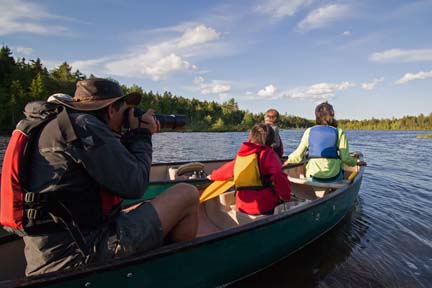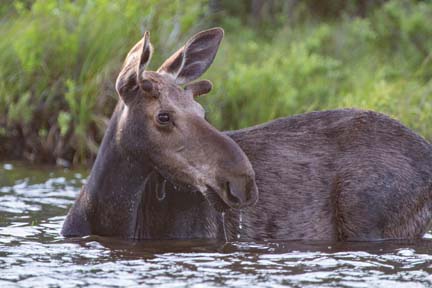‘Moose safari’ gets lucky in the Moosehead region
By Aislinn Sarnacki
BDN Staff
It’s hard to say who saw the moose first.
As the train of four canoes rounded a bend in the pond on June 21, everyone’s paddles stilled and their heads turned to the grassy bank on the left, where a big cow moose stood with its head bowed, munching on vegetation at the edge of the water.
 BDN photo/Aislinn Sarnacki
BDN photo/Aislinn Sarnacki
ON SAFARI — Tom De Schepper from Rio de Janeiro, Brazil, and his two children, Elisa and Lucas, watch a moose eat aquatic plants in a pond on June 21 in the Moosehead Lake region during a moose tour led by Northeast Whitewater guide service of Shirley. The three, along with Tom’s wife, Suzy, attended the tour while vacationing in the area.
The canoes drifted in silence. The moose continued its meal, seemingly unaware of the wide-eyed audience.
Quietly, Ashley Patterson, a Maine registered guide and the leader of the “moose safari,” motioned for everyone to gather together, then for each person to grasp the gunwales of the canoe beside theirs, forming a raft of four boats, floating side by side.
“Moose have poor eyesight,” Patterson had told the nine-person group earlier that afternoon, during the van ride from Northeast Whitewater Lodge and Guide Service headquarters in Shirley Mills to the remote pond east of Moosehead Lake.
Yet what moose lack in sight they make up for with a great hearing and sense of smell. As the raft of canoes drifted to the edge of the pond, about 70 feet from the grazing animal, Patterson leaned over the side of her canoe and started rubbing a nearby plant between her fingers. Bog laurel, she would explain later, is a common plant growing around Maine ponds and lakes, and it’s a soothing scent for moose.
“Sometimes it works, sometimes it doesn’t,” Patterson said.
In this case, it didn’t hurt. Parting the tall grass, the moose stepped gracefully down into the pond and waded past the canoes until the water reached the animal’s shoulders. Then, dunking its head under the water, the moose began to graze on the mineral-rich plants hidden below the surface.
The paddlers sat quietly, darting looks at one another, grinning from ear to ear but not daring to speak. And after a few silent seconds, the moose rose its head, water dripping from its ears and long snout, soggy green stems trailing from its mouth. They were so close they could hear the plants crunch between the moose’s teeth as it chewed.
“Paying attention to body language is so important,” Patterson had said to the group earlier when talking about safely observing moose at close range. “This is something we take so seriously.”
One of several guides working for Northeast Whitewater Lodge and Guide Service, Patterson has been leading moose safaris for nine years. She has been a registered Maine guide in recreation, fishing and hunting for 20 years. From late spring through the fall, she’s prepared to guide moose safaris two times per day, seven days per week.
“You make hay when the sun shines,” Patterson said.
Headquartered in a beautiful log building off Greenville Road in Shirley Mills, Northeast Whitewater Lodge and Guide Service offers private and group moose tours by van and canoe from May 1 through Oct. 9, as well as whitewater rafting trips and guided wildlife photography excursions. The outfit is owned by native Mainers and registered Maine guides Jeremy and Jessica Hargreaves, who employ a team of guides throughout the season to lead clients on these specialized outdoor adventures.
“Leading trips and meeting people is always the wonderful part of doing this line of work,” Jessica Hargreaves said. “We get to meet people from all over the world, and that’s such a cool thing.”
On June 21, Patterson’s moose tour was a mother-daughter duo from Florida, a husband and wife from Maryland and a four-person family from Rio de Janeiro in Brazil.
“Most of our clients are from away because more people who live in Maine have the opportunity to try to find a moose on their own,” Jessica Hargreaves said. “But the unique thing about taking a guided tour is that you have someone who has experience and knows the area bring you to spots where you are most likely to see a moose.”
The best time to look for moose is first thing in the morning and just before sunset, Patterson said. An ideal temperature is 63 degrees Fahrenheit or cooler, she added, but weather comes into play as well.
“There are so many factors that go into it,” Patterson said. “Sometimes we see nine moose on a pond just before a downpour or storm and the next day zero.”
At the end of the day, whether or not you see a moose or any other Maine wildlife is all a matter of luck.
“We’re lucky to see a moose in general because it’s a wild animal,” Patterson said. “It’s a privilege to see it in its natural habitat.”
Maine moose guides can never guarantee a moose sighting, but in late spring and early summer, Patterson said she has about a 98 percent chance of finding a moose on her tours. And on the rare occasion that she gets “skunked,” she does her utmost to entertain her clients with the vast knowledge she’s acquired over the years about local plant life and wildlife.
As summer matures, moose become increasingly more difficult for tour guides to predict, and in the fall, during moose mating season, the challenge is even greater, Patterson said.
“When the fall colors start to change in late September, it’s an absolutely beautiful time to visit,” Jessica Hargreaves said. “But that’s the most difficult time to see a moose. The reason is, they go into ruts and are less predictable. … But that’s when the bull moose has its big antler rack, and everybody wants to get a picture of that.”
Because it’s difficult to talk to people separated into four canoes, Patterson spent the one-hour van ride to the pond — which will remain unnamed as a courtesy to the guide service and the moose — rattling off stories and interesting facts about moose.
The state’s estimated moose population is 68,000, she told the group as she navigated the rough gravel roads leading to the pond. Yet the hulking creatures are not easy to find. They’re solitary animals.
An adult moose can hold their head underwater up to 1 minute 48 seconds, she told the group — a fact that cannot be found in any textbook or on any website but comes from Patterson’s firsthand experience of watching one of Maine’s most iconic creatures day after day.
“This time of year, all they want to do is eat,” Patterson said. During the summer, adult moose eat up to 50 pounds of food per day. In addition to aquatic plants, they browse on young trees, such as mountain ash and white birch.
As the group watched the large cow moose feed in the pond on June 21, they were startled as a year-old male moose emerged from the forest to gaze upon the larger female. Upon noticing him, she perked up her ears and stared: a challenge. This was her feeding ground, and one of the canoeists spotted her newborn calf hiding in the grass nearby.
Using her paddle and sometimes climbing out of the canoe to wade in the shallow water, Patterson had positioned her clients out of the way but close enough to observe.
“I’m not going to endanger your life,” Patterson explained. “It’s common sense. We’re not going to get between a mother and a newborn calf.”
Cameras clicking (without flash), the rapt canoeists followed the young male moose as he strode along the shore with his long, gangly legs, right past the raft of canoes and into the sunset. Silhouetted by the golden sunlight, he paused, snatched up a few leaves, chewed and slobbered. Then, after several minutes, he waded across a shallow section of the pond to the other side, where he clumsily clambered up the bank and disappeared into the forest.
The cow moose, still shoulder deep in the water, called out in low grunts. Waited. Called out again. Then, for some reason unknown to the group, started swimming almost straight at the canoes, passed within feet of the group and followed the yearling male up the bank and into the forest.
“An experience like that, with a yearling walking the shoreline right beside the canoes, that happens maybe three or five times a year,” Patterson said on the van ride back to the guide company’s headquarters. “But to have one swimming beside the canoe like that? That was a 1,000-pound cow.
“It doesn’t get much better than that,” she said. “You may want to go play the lottery now.”
That evening, Patterson would write in her mandatory moose report for the guide service that her evening tour had spotted six moose — a cow and calf by the road, an adult bull walking down the road leisurely and a cow, calf and yearling on the pond — as well as a young black bear, which darted across the road during their drive, a porcupine by the road, an osprey wheeling in the air above the pond, a family of ducks and a loon.
To learn more about Northeast Whitewater Lodge and Guide Service, visit northeastwhitewater.com or call 645-0151.
 BDN photo/Aislinn Sarnacki
BDN photo/Aislinn Sarnacki
LOOKING FOR MOOSE — A male yearling moose wades near the shore of a pond in the Moosehead Lake region, putting on a show for several families paddling canoes on a moose tour led by Northeast Whitewater guide service of Shirley.